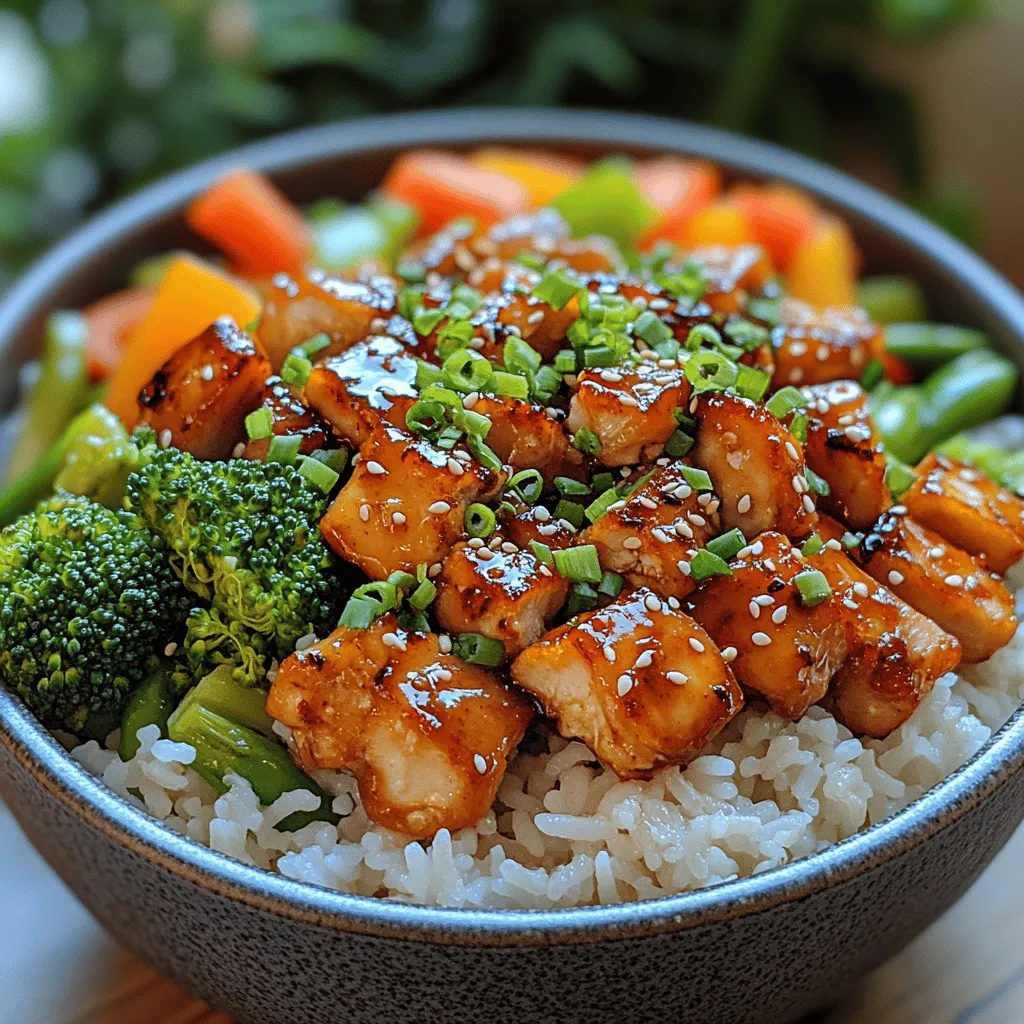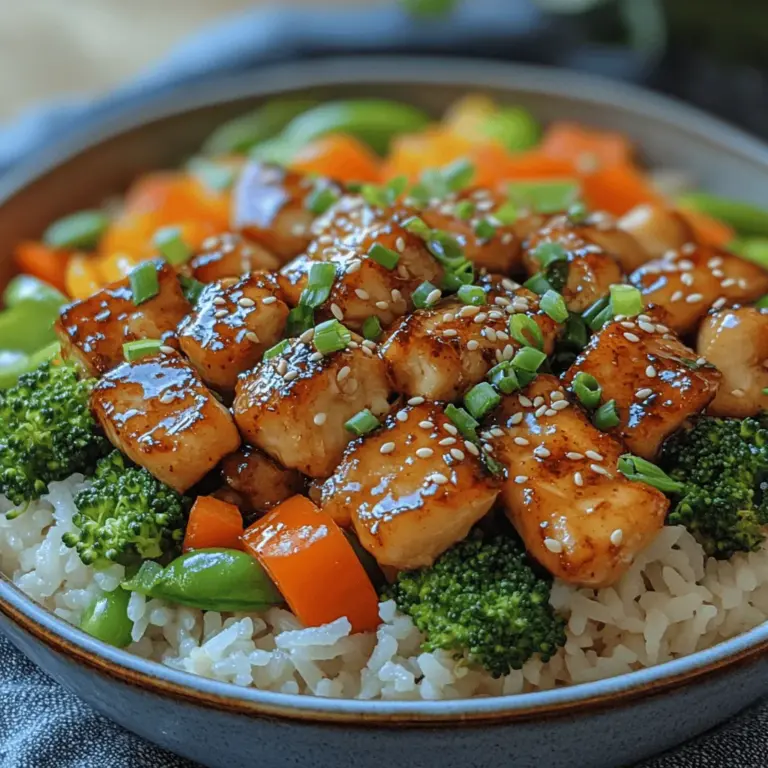Introduction to Teriyaki Chicken Rice Bowl
The Teriyaki Chicken Rice Bowl is a beloved dish that has captured the hearts (and taste buds) of food enthusiasts around the globe. Originating from the Japanese culinary tradition, teriyaki refers to a cooking technique in which food is grilled or broiled with a glaze made from soy sauce, mirin, and sugar. This method not only enhances the flavor of the chicken but also creates a beautiful, glossy finish that makes the dish visually appealing. The combination of succulent chicken, savory teriyaki sauce, and fluffy rice makes it a comforting meal perfect for any occasion.
What truly sets the Teriyaki Chicken Rice Bowl apart is its versatility. It can be made quickly for a weeknight dinner or dressed up for special occasions. The dish is easily customizable, allowing you to incorporate seasonal vegetables or substitute proteins according to your dietary preferences. Whether served as a hearty lunch or a satisfying dinner, this rice bowl offers a delightful balance of flavors and textures that appeals to both children and adults alike.
Beyond its deliciousness, the Teriyaki Chicken Rice Bowl is also a nutritional powerhouse. Boneless, skinless chicken breast is an excellent source of lean protein, while the addition of mixed vegetables provides essential vitamins and minerals. Jasmine rice, the traditional base for this dish, is not only fragrant but also a good source of carbohydrates, providing the energy necessary for a busy day. With the right choices in ingredients, you can create a well-rounded meal that aligns with your health goals.
Ingredients for Teriyaki Chicken Rice Bowl
Creating the perfect Teriyaki Chicken Rice Bowl starts with choosing high-quality ingredients. Here’s a detailed breakdown of what you will need:
1. Boneless, Skinless Chicken Breasts
The star of this dish is the boneless, skinless chicken breast. This lean protein is not only easy to cook but also absorbs the teriyaki sauce beautifully, creating a tender and flavorful bite. When selecting chicken, look for pieces that are plump and have a light pink hue, indicating freshness.
2. Jasmine Rice
Jasmine rice is the ideal choice for this recipe due to its subtle floral aroma and slightly sticky texture when cooked. Originating from Thailand, jasmine rice complements the flavors of the teriyaki sauce perfectly and provides a satisfying base for the dish. If you can’t find jasmine rice, basmati rice can be a suitable substitute.
3. Teriyaki Sauce
You have the option of using store-bought or homemade teriyaki sauce. While store-bought varieties are convenient and readily available, making your own teriyaki sauce allows you to control the flavor profile and ingredients. A basic homemade teriyaki sauce typically includes soy sauce, mirin (or rice vinegar), sugar, and ginger, which can be adjusted according to your taste preferences.
4. Sesame Oil and Vegetable Oil
Both sesame oil and vegetable oil play crucial roles in the cooking process. Vegetable oil, such as canola or grapeseed oil, has a high smoke point, making it perfect for stir-frying the chicken. In contrast, sesame oil adds a rich, nutty flavor that enhances the overall taste of the dish. Use sesame oil sparingly, as its strong flavor can easily overpower other ingredients.
5. Mixed Vegetables
Incorporating a variety of mixed vegetables not only adds color to your dish but also boosts its nutritional value. Common choices include bell peppers, broccoli, snap peas, or carrots. These vegetables provide essential vitamins, minerals, and fiber, making your Teriyaki Chicken Rice Bowl even healthier.
6. Garnishes: Green Onions and Sesame Seeds
Finally, garnishing your dish with chopped green onions and sesame seeds adds both flavor and visual appeal. Green onions contribute a fresh, crisp bite, while sesame seeds provide a delightful crunch and a hint of nuttiness. These simple garnishes elevate the dish and make it look professionally plated.
Preparation: Cooking the Rice
Cooking the rice is a crucial step that sets the foundation for your Teriyaki Chicken Rice Bowl. To achieve the best results, follow these essential steps:
Importance of Rinsing Jasmine Rice
Before cooking jasmine rice, it’s important to rinse it under cold water. Rinsing removes excess starch, which can cause the rice to become gummy when cooked. Instead, you want each grain to remain fluffy and separate.
Step-by-Step Instructions on Cooking Rice
1. Measure the Rice: Use 1 cup of jasmine rice for every 1.5 to 2 cups of water (or chicken broth, if you prefer).
2. Rinse: Place the measured rice in a fine-mesh strainer and rinse under cold water until the water runs clear. This usually takes about 1-2 minutes.
3. Combine Ingredients: In a medium-sized saucepan, combine the rinsed rice and water (or chicken broth). If you prefer a bit more flavor, adding a pinch of salt can enhance the taste.
4. Boil: Bring the mixture to a boil over medium-high heat.
5. Simmer: Once boiling, reduce the heat to low, cover the pot with a tight-fitting lid, and let it simmer for about 15-20 minutes. Do not lift the lid during this time, as steam is crucial for properly cooking the rice.
6. Fluff: After the cooking time is up, remove the pot from heat and let it sit, covered, for an additional 5 minutes. This allows the rice to finish steaming. Finally, use a fork to fluff the rice gently before serving.
Explanation of Using Water vs. Chicken Broth
While water is the traditional cooking liquid for rice, using chicken broth adds a depth of flavor that enhances the overall dish. The choice between water and broth ultimately depends on your flavor preferences and dietary restrictions. If you choose to use broth, opt for low-sodium versions to keep the dish healthier.
Tips for Achieving the Perfect Fluffy Rice
– Ratio of Rice to Liquid: Adjust the ratio of rice to liquid based on the type of rice you are using. Jasmine rice typically requires less water than other types.
– Avoid Stirring: Once the rice is simmering, avoid stirring it. Stirring can break the grains and lead to a mushy texture.
– Invest in a Rice Cooker: If you frequently cook rice, consider investing in a rice cooker for perfectly cooked rice every time with minimal effort.
Preparing the Chicken
Properly preparing the chicken is essential for achieving a flavorful Teriyaki Chicken Rice Bowl. Here are some important tips:
Importance of Seasoning Chicken Before Cooking
While the teriyaki sauce will provide the primary flavor, seasoning the chicken with a little salt and pepper before cooking enhances its taste. A simple seasoning improves the overall depth of flavor in the dish.
Tips for Slicing Chicken Breasts into Bite-Sized Pieces
When cutting chicken breasts, it’s best to slice them against the grain. This technique ensures that the chicken remains tender and easy to chew. Aim for bite-sized pieces that will cook evenly and absorb the teriyaki sauce beautifully.
Discussion on the Cooking Techniques for Chicken (Stir-Frying)
Stir-frying is an excellent cooking method for teriyaki chicken, as it allows for quick cooking over high heat, preserving the chicken’s moisture and tenderness. To achieve the best results, ensure your pan or wok is preheated before adding the chicken. This helps to sear the meat, creating a delicious browned exterior that enhances the overall flavor of your rice bowl.
Cooking the Chicken and Vegetables
Now that your rice is cooked and your chicken is prepped, it’s time to bring everything together. Follow these detailed instructions for cooking the chicken and vegetables:
Detailed Instructions on Heating Oils and Cooking Chicken
1. Heat the Pan: Place a large skillet or wok over medium-high heat and add 1 tablespoon of vegetable oil. Allow the oil to heat until it shimmers, indicating it’s ready for cooking.
2. Add Chicken: Carefully add the sliced chicken to the pan in a single layer. Avoid overcrowding the pan, which can cause steaming instead of frying. If necessary, cook the chicken in batches.
3. Cook Until Browned: Stir-fry the chicken for about 5-7 minutes, or until it is cooked through and reaches an internal temperature of 165°F (74°C). The chicken should be nicely browned and caramelized for maximum flavor.
Importance of Achieving Browning for Flavor
Browning the chicken creates a Maillard reaction, which enhances the overall flavor profile of the dish. The caramelization of sugars in the chicken creates a rich depth of flavor that pairs beautifully with the sweet notes of teriyaki sauce.
Step-by-Step Instructions on Adding Vegetables
1. Introduce Vegetables: Once the chicken is nearly cooked, add your mixed vegetables to the pan. Stir-fry for an additional 3-5 minutes until the vegetables are tender yet crisp.
2. Monitor Texture: Aim for a balance between tenderness and crispness in your vegetables. Overcooking can lead to mushiness, which detracts from the dish’s overall appeal.
Discussion on the Ideal Texture for Vegetables (Tender Yet Crisp)
The right texture for vegetables in a Teriyaki Chicken Rice Bowl is crucial for creating a satisfying dish. They should be tender enough to bite through easily but still retain a slight crunch. This contrast in textures adds interest to the dish and keeps every bite enjoyable.
As you cook the chicken and vegetables, the aroma will fill your kitchen, making it hard to resist the temptation to dive in. Stay tuned for the next part, where we’ll incorporate the teriyaki sauce and finish off this delicious rice bowl!

The Flavorful Impact of Teriyaki Sauce
Teriyaki sauce is a central element in creating a delicious Teriyaki Chicken Rice Bowl. This sauce, with its perfect balance of sweet and savory flavors, elevates the dish from simple chicken and rice to an extraordinary culinary experience. Typically made from soy sauce, mirin (a sweet rice wine), and sugar, teriyaki sauce provides a glossy finish to the chicken, allowing it to caramelize beautifully during cooking.
When you add the teriyaki sauce to the cooked chicken, it envelops each piece, infusing it with flavor while creating a moist texture. The sugars in the sauce help to create that sought-after glaze, giving your chicken a beautiful sheen. Remember to keep stirring the chicken in the sauce to ensure that it’s evenly coated and to help the flavors meld seamlessly.
Instructions for Adding Teriyaki Sauce
1. Prepare the Chicken: Once the chicken is fully cooked, remove it from the heat. If you are using leftover chicken, ensure it is warmed through.
2. Add the Sauce: Pour the teriyaki sauce over the chicken pieces in the skillet.
3. Stir Well: Gently toss the chicken in the sauce using a spatula or wooden spoon. Ensure that every piece is coated with the sauce.
4. Simmer for Consistency: Allow the chicken to simmer in the sauce on low heat for 2-3 minutes. This simmering not only helps the sauce to thicken slightly but also allows the flavors to deepen.
Recognizing the Right Consistency of Teriyaki Sauce
The ideal teriyaki sauce should have a syrupy consistency that clings to the chicken. If the sauce is too thin, it may not coat the chicken well, leading to a watery dish. Conversely, if the sauce becomes too thick, it can overpower the chicken’s flavor. The right consistency will allow the sauce to form a shiny glaze that enhances the chicken without drowning it. If you find your sauce too thin, let it simmer a bit longer to reduce and thicken it. If it’s too thick, a splash of water or chicken stock can help achieve the right texture.
Assembling the Teriyaki Chicken Rice Bowl
Now that your chicken is perfectly glazed with teriyaki sauce, it’s time to assemble your rice bowl. This stage is not only about combining ingredients but also about creating a visually appealing dish that enhances the dining experience.
1. Base Layer: Start with a generous serving of cooked rice as the base. White rice, brown rice, or even jasmine rice work wonderfully.
2. Add Chicken: Next, layer the teriyaki chicken on top of the rice. Ensure that the chicken is evenly distributed for balanced flavor in every bite.
3. Incorporate Vegetables: Add a variety of colorful vegetables such as steamed broccoli, shredded carrots, or snap peas. These not only add nutrition but also provide a vibrant contrast to the chicken and rice.
4. Drizzle Extra Sauce: For those who enjoy a saucier bowl, a light drizzle of additional teriyaki sauce on top can enhance the flavor profile.
5. Garnish: Finish with garnishes such as sesame seeds, chopped green onions, or nori strips for added crunch and flavor.
Importance of Presentation
The presentation of your Teriyaki Chicken Rice Bowl plays a crucial role in meal enjoyment. A well-arranged bowl not only makes the dish more appetizing but also reflects the care put into the preparation.
Suggestions for Portion Sizes
When serving, consider the portion sizes based on individual preferences and dietary needs. Generally, a serving of rice should be about 1 cup, with around 4-6 ounces of chicken and a good handful of vegetables. Adjust these proportions based on guests’ appetites or specific dietary goals.
Garnishing and Serving
Garnishes serve a dual purpose: they enhance visual appeal and add layers of flavor. A sprinkle of sesame seeds can provide a nutty crunch, while fresh herbs can elevate the freshness of the dish.
Importance of Fresh Ingredients
Using fresh ingredients not only improves the flavor but also boosts the nutritional content of your meal. Fresh vegetables retain more vitamins and minerals compared to their canned or frozen counterparts. When garnishing, consider using fresh herbs like cilantro or parsley, which can brighten up the dish and make it more vibrant.
Serving Options
When it comes to serving your Teriyaki Chicken Rice Bowl, you have several options. You can serve individual bowls for a more personalized experience, or you could present a family-style serving where everyone helps themselves. Family-style serving encourages sharing and can create a more communal dining atmosphere.
Nutritional Benefits of Teriyaki Chicken Rice Bowl
The Teriyaki Chicken Rice Bowl is not only delicious but also packed with nutritional benefits.
Breakdown of Nutritional Content
– Protein: Chicken is an excellent source of lean protein, helping to build muscle and keep you feeling full.
– Carbohydrates: Rice provides the necessary carbohydrates for energy. Choosing brown rice can increase fiber content, contributing to better digestion.
– Vitamins: The addition of vegetables such as broccoli and carrots adds essential vitamins and minerals, including vitamin A, vitamin C, and potassium.
Health Benefits of Chicken and Vegetables
The inclusion of chicken in this dish provides essential amino acids, which are crucial for various bodily functions. Additionally, the vegetables contribute antioxidants that can bolster your immune system and overall health. This balance makes the Teriyaki Chicken Rice Bowl a well-rounded meal option.
Importance of Balanced Meals and Meal Prep
Incorporating a variety of food groups in your meals ensures that you receive a broad spectrum of nutrients. The Teriyaki Chicken Rice Bowl exemplifies a balanced meal with protein, carbohydrates, and healthy fats (from garnishes like sesame seeds). Preparing this dish in advance can simplify meal prep for busy weeks, allowing for nutritious homemade meals even on the go.
Variations and Customizations
The beauty of the Teriyaki Chicken Rice Bowl lies in its versatility. You can customize it to suit your taste preferences or dietary restrictions.
Suggestions for Ingredient Substitutions
– Proteins: If chicken isn’t your preference, consider using tofu, shrimp, or beef. Each protein brings its own unique flavor profile to the dish.
– Vegetables: Feel free to mix and match vegetables based on what you have on hand. Bell peppers, zucchini, and bok choy are great alternatives.
Vegan or Vegetarian Options
For a vegan option, substitute chicken with tofu or tempeh and ensure the teriyaki sauce is free from animal products. You can also add more vegetables or incorporate a grain like quinoa for added nutrition.
Ideas for Spicing Up the Dish
If you’re looking to add a little heat, consider incorporating red pepper flakes or a drizzle of sriracha. Alternatively, experimenting with different sauces, such as hoisin or sweet chili sauce, can add a unique twist to your Teriyaki Chicken Rice Bowl.
Cultural Significance of Teriyaki Cuisine
Teriyaki cooking has rich cultural roots in Japanese cuisine. The method of grilling meat and glazing it with sauce has been a staple for centuries.
Brief History of Teriyaki Cooking
Teriyaki, which translates to “glaze-broiled,” originated in Japan where it was traditionally made using fish or meat. Initially, the focus was on enhancing the natural flavors of the ingredients through a simple marinade. Over time, teriyaki sauce evolved, incorporating various ingredients to cater to diverse palates worldwide.
Explanation of Its Roots in Japanese Cuisine
In Japan, teriyaki is often associated with summer barbecues, where chicken or fish is grilled and coated in a sweet glaze. This cooking method emphasizes the quality of the ingredients and the art of balancing flavors, which is a hallmark of Japanese culinary traditions.
Discussion on How the Dish Has Evolved Internationally
As teriyaki cuisine spread beyond Japan, it adapted to different cultures and tastes. In the United States, for instance, teriyaki chicken became a popular dish in Asian-American cuisine, often served with rice and vegetables. This international adaptation showcases how food can transcend borders while retaining its cultural essence.
Conclusion: Enjoying Your Homemade Teriyaki Chicken Rice Bowl
The Teriyaki Chicken Rice Bowl is a delightful dish that combines flavor, nutrition, and versatility. Its ease of preparation makes it a perfect choice for busy weeknights or relaxed weekends spent enjoying time with family and friends.
With the opportunity to customize and adapt the recipe to suit various dietary needs and preferences, this dish is not only a meal but a canvas for your culinary creativity.
As you explore the variations and make the recipe your own, you’ll discover the joy of cooking and the satisfaction of enjoying a homemade meal. Embrace the experience, and savor the flavors of your very own Teriyaki Chicken Rice Bowl, knowing that every bite is infused with care and creativity.

